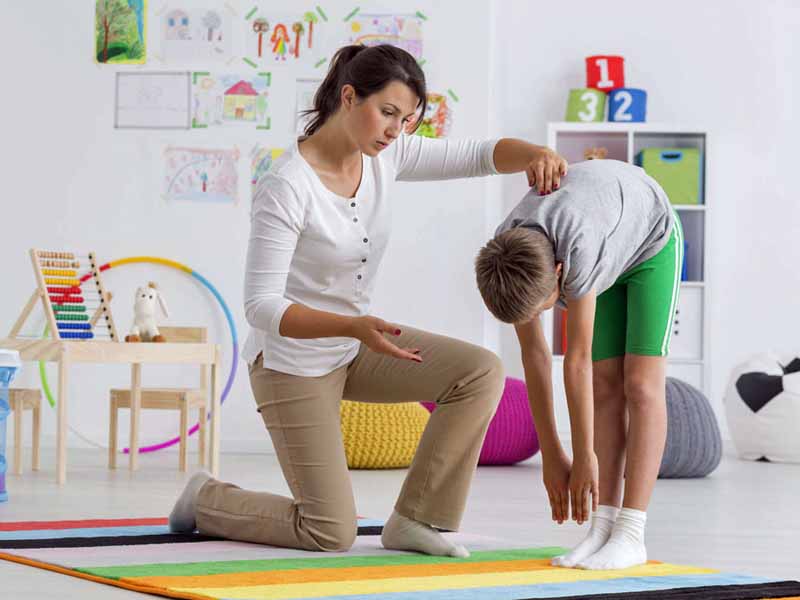USPSTF: Evidence Lacking on Scoliosis Screening in Kids, Teens
AAFP's Stance Mirrors Task Force Guidance
January 11, 2018, 03:41 pm News Staff — On Jan. 9, the U.S. Preventive Services Task Force (USPSTF) published a final recommendation statement and evidence summary on screening for adolescent idiopathic scoliosis in children and adolescents ages 10-18 who are asymptomatic for the condition.

The USPSTF concluded there was insufficient evidence to assess the balance of benefits and harms of screening in this age group -- an "I" statement.
Scope of the Problem
Adolescent idiopathic scoliosis (lateral spinal curvature with a Cobb angle of at least 10 degrees) is the most common form of scoliosis, affecting about 1 percent to 3 percent of U.S. youth in this age range. The condition typically worsens in adolescence, and patients with a Cobb angle of more than 40 degrees at skeletal maturity are likely to experience curvature progression as adults.
Severe spinal curvature may be associated with adverse long-term health consequences, including pulmonary disorders, back pain, psychological effects and disability. Early detection and treatment could slow or stop curvature progression before the patient reaches skeletal maturity and, thus, may improve long-term outcomes.
However, the task force found no direct evidence on the effect screening for adolescent idiopathic scoliosis had on patient-centered health outcomes. Although adequate evidence indicated that treatment with bracing may decrease curvature progression in adolescents with mild or moderate curvature severity -- an intermediate outcome -- evidence regarding the association between reduced spinal curvature in adolescence and long-term health outcomes in adulthood was lacking.
Story Highlights
"Our review of the current evidence has pointed to more questions than answers about the benefits and harms of screening children and teenagers with no symptoms of scoliosis," said USPSTF member Alex Kemper, M.D., M.P.H., M.S., in a news release. "We know that screening can accurately detect scoliosis, but it's unclear what effects scoliosis screening and treatment have on children's health in adolescence and into adulthood."
Screening Details and Followup
Screening is usually done by visual inspection of the spine to look for asymmetry of the shoulders, scapulae and hips. The forward-bend screening test is most commonly used in the United States. Patients are instructed to bend forward so that the spine is parallel to the floor, making it easier to perceive any unevenness. Physicians may also use a scoliometer to measure the angle of trunk rotation during the forward-bend test. A trunk rotation angle of 5 degrees to 7 degrees often is the threshold for referral to radiography.
Screening may also be conducted using a humpometer, the plumb line test and Moiré topography (creating a three-dimensional image of the surface of a patient's back).
If idiopathic scoliosis is suspected, radiography is used to confirm the diagnosis and to quantify the degree of curvature and the Risser sign value.
Recommendation Background
This final recommendation statement is consistent with the USPSTF's 2017 draft recommendation statement and represents a revision of its 2004 final "D" recommendation against screening for adolescent idiopathic scoliosis in children and adolescents with no signs or symptoms.
Also this week, the AAFP released its own final recommendation statement on the topic that mirrors the task force's guidance.
Research that's new since the 2004 recommendation was issued suggested that use of a back brace could be beneficial to patients with scoliosis. However, the task force said more research is needed on other types of treatment, as well as on short- and long-term effects of screening and treatment.
The task force invited stakeholders to comment on its draft recommendation statement between May 30 and June 26, 2017. During that time, many commenters were concerned with the change in letter grade of the recommendation from "D" in 2004 to "I".
In response, the task force added language noting that in 2004, the USPSTF found fair evidence to show that treating adolescent idiopathic scoliosis led to decreased pain and disability in a small proportion of patients. At the same time, the task force found the evidence regarding potential treatment harms to be moderate and concluded that the harms of screening exceeded the potential benefits. Newer research, however, led the USPSTF to conclude that it no longer had moderate certainty that the harms of treatment outweighed the benefits.
Some commenters asked for clarification on the recommendation's target population, so the USPSTF clarified that the recommendation applies to asymptomatic children and adolescents ages 10-18. The recommendation does not apply to children and adolescents who present for evaluation of back pain, breathing difficulties, abnormalities found on radiography or other imaging studies, or obvious deformities in spinal curvature.
Finally, other commenters expressed concern that the evidence needed to change the recommendation grade appeared to be unattainable. In response, the USPSTF added language laying out in detail what types of studies and outcomes of interest would be required to fill the research gaps that remain on this topic.
"These gaps in the current body of evidence have led the task force to issue an 'I' statement, which is a call for more research to address the uncertainty in evidence about scoliosis screening," said USPSTF member and family physician John Epling Jr., M.D., M.S.Ed., in the news release. "Until more conclusive evidence is available, primary care clinicians should continue to use their clinical judgment when deciding which patients to screen for this condition."
More From AAFP
American Family Physician: Adolescent Idiopathic Scoliosis: Diagnosis and Management
(2/1/2014)